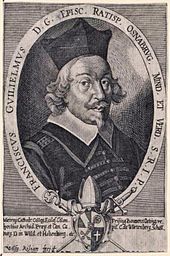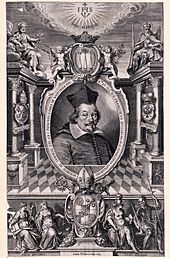Franz Wilhelm von Wartenberg
Franz Wilhelm Cardinal Reichsgraf von Wartenberg (born March 1, 1593 in Munich , † December 1, 1661 in Regensburg ) was a cardinal from a sideline of the Wittelsbach Princely House . He is one of the most important prince-bishops of Osnabrück and Regensburg ; he also headed the dioceses of Minden and Verden . 1621-1640 he was Prime Minister of the Electorate of Cologne .
Life
Origin and education
Franz Wilhelm came from the morganatic marriage of Prince Ferdinand of Bavaria , the son of the Bavarian Duke Albrecht V of Bavaria , with Maria von Pettenbeck. 1602 he became, like his siblings, the emperor as Graf von Wartenberg in the realm count was raised, with the name of the rule Wartenberg was elected in Upper Bavaria.
Between 1601 and 1604 Franz Wilhelm attended the Jesuit College in Ingolstadt , graduated from the Jesuit High School in Munich in 1608 (today: Wilhelmsgymnasium Munich ) and then studied theology at the Collegium Germanicum et Hungaricum in Rome . In 1614 he received minor orders from Cardinal Robert Bellarmine .
Career as a clergyman
In 1614 he was first president of the clergyman, and from 1619 of the Bavarian Secret Council in Munich . In 1621 he moved to the Bonn court of the Cologne Elector, his cousin Ferdinand of Bavaria , as President of the Privy Council and Colonel Hofmeister . Until 1640 he determined politics here as Prime Minister of the Electorate of Cologne.
As early as 1604 he was appointed provost of the Altötting monastery , in 1617 as canon in Regensburg and in 1618 in Freising and in 1629 as provost of the important St. Cassius monastery in Bonn . Further church benefices followed.
Provost of the Bonn St.-Cassius-Stift
Since 1629 he was provost of the most important monastery of the Cologne Archdiocese , which has been documented since the 7th century. In this position he was the first to introduce the Roman rite into the church in the royal seat of the Electorate of Cologne, Bonn. In 1641 he obtained the papal privilege of wearing a miter and staff from Pope Urban VIII for the Bonn provosts of the Cassius monastery . These pontificals were otherwise reserved for bishops. In addition, he donated the bronze statue of Saint Helena , which Jeremias Geißelbrunn created around 1630, still in Bonn Minster, from his own fortune .
Bishop of Osnabrück
From 1625 to 1661 he was Bishop of Osnabrück . The acceptance and papal confirmation of the election was delayed until 1628 because the Danes tried to influence the election during their occupation in Osnabrück. Franz Wilhelm continued the reform work of his predecessor Eitel Friedrich von Hohenzollern in the Diocese of Osnabrück with an iron hand . In Osnabrück he deposed the Lutheran city council, had the Petersburg citadel built and expanded the Carolinum grammar school into a Jesuit university . He regularly invited the diocesan clergy to synods in order to proclaim and implement the reform decisions of the Council of Trent , to which he felt himself only partially bound - because an accumulation of offices was not desired. In the Lower Saxony district, Franz Wilhelm became the imperial commissioner, who now implemented the edict of restitution .
Bishop of Minden and Verden
Franz Wilhelm's achievements received great attention in the papal curia . In 1630, Pope Urban VIII awarded him the almost secularized dioceses of Verden and Minden and appointed him papal administrator in the diocese of Hildesheim . With the advance of the Swedes into northern Germany - in 1633 they occupied the bishopric of Osnabrück - the reform efforts were initially halted. Wartenberg retired to Cologne, where he was on 25 May 1634 sub-deacon ordained and received on 4 June 1634, the diaconate . Albert von Toerring-Stein , Bishop of Regensburg , donated him to the priesthood on November 29, 1636 in Regensburg . The episcopal ordination received Franz Wilhelm von Wartenberg on December 8, 1636 Regensburg by the Apostolic Nuncio Malachia Malatesta Baglioni , bishop of Pesaro , with the assistance of the Regensburg Bishop Albert of Toerring-Stein and Anton Wolfradt , bishop of Vienna . In 1645 he was appointed Vicar Apostolic for the Archdiocese of Bremen and in 1649 Bishop of Regensburg.
During the negotiations for the Peace of Westphalia between Osnabrück and Münster from 1643 to 1648 , Franz Wilhelm temporarily represented the interests of 17 Catholic foundations and abbeys as a negotiator . Through the peace treaty , Franz Wilhelm received the Osnabrück bishopric again , but he could not prevent the provisions that after his death a Catholic and Lutheran bishop from the house of Braunschweig-Lüneburg should alternate.
Bishop of Regensburg
Franz Wilhelm held synods in the Regensburg diocese after his appointment as Bishop of Regensburg and again in 1660. After these two synods there was a break of several centuries. A diocesan synod was not convened again until 1927 .
As a result of war, looting and the plague, the convents of almost all monasteries had shrunk to a minimum, and in the countryside there was a shortage of pastors who lived in poor conditions and who officials and nobles disputed claims based on the documents lost in the war.
Other catacomb saints came to Regensburg as relics, such as Saint Leonitus and the saints and martyrs Aurelius and Adrianus.
End of life
The last years of his life, Bishop Franz Wilhelm, who did not let up in his reform zeal, alternated between Regensburg and Osnabrück. Pope Alexander VII , who as Fabio Chigi was Franz Wilhelm's companion during his time as Nuncio in Cologne and papal peace negotiator in the negotiations for the Peace of Westphalia in Münster, appointed him a year and a half before his death on April 5, at the suggestion of the Emperor Cardinal in 1660 .
Franz Wilhelm von Wartenberg was buried in the collegiate church of Altötting . His heart was buried separately and is located in the Chapel of Grace in Altötting .
coat of arms
Since 1649, the multiple prince-bishop kept the coat of arms of the dioceses of Regensburg (from the viewer top left, heraldic top right), Osnabrück (top right, heraldic top left), Minden (bottom left, heraldic bottom right) and Verden (bottom right) in a crossing , heraldic lower left). The heart shield shows the Wartenberg family coat of arms (a Wittelsbach bastard coat of arms ), a red-tongued golden lion on the silver and blue Bavarian diamonds .
Literary reception
Writing freedom: Ricarda Huch lets the prince-bishop appear as a witness in a trial of an egg-laying rooster in Quakenbrück in her cheerful story Der Hahn von Quakenbrück , published in 1910 .
literature
- Alice Arnold: Franz Graf von Wartenberg. In: Jürgen Wurst, Alexander Langheiter (Ed.): Monachia. By Carl Theodor von Piloty in the Munich City Hall. Städtische Galerie im Lenbachhaus, Munich 2005, ISBN 3-88645-156-9 , p. 89.
- Michael Buchberger (Ed.): Twelve Hundred Years Diocese of Regensburg. Festschrift for the 1200th anniversary. Pustet in Kommission, Regensburg 1939, pp. 58–60.
- Bernard Anton Goldschmidt: Life story of the Cardinal-Priest Franz Wilhelm, Count of Wartenberg, Prince-Bishop of Osnabrück and Regensburg, Minden and Verden. Richard, Osnabrück 1866 ( digitized in the Google book search).
- Karl Hausberger : History of the diocese of Regensburg. Volume 1: Middle Ages and Early Modern Times. Pustet, Regensburg 1989, ISBN 3-7917-1188-1 , pp. 336-343.
- Karl Hausberger: Wartenberg, Franz Wilhelm. In: Erwin Gatz , Stephan M. Janker (Ed.): The Bishops of the Holy Roman Empire. A biographical lexicon. 1648-1803. Duncker and Humblot, Berlin 1990, ISBN 3-428-06763-0 , pp. 558-561.
- Friedrich Philippi : Franz Wilhelm von Wartenberg . In: Allgemeine Deutsche Biographie (ADB). Volume 41, Duncker & Humblot, Leipzig 1896, pp. 185-195.
- Konrad Repgen : Wartenberg, Chigi and Knöringen in the year 1645. The emergence of the plan for the papal protest against the Peace of Westphalia as a source-historical and methodological problem. In: Rudolf Vierhaus , Manfred Botzenhardt (Hrsg.): Duration and change of history. Aspects of the European Past. Ceremony for Kurt von Raumer on December 15, 1965 (= New Münster Contributions to Historical Research . Vol. 9, ISSN 0077-7706 ). Aschendorff, Münster 1966, pp. 213-268.
- Georg Schwaiger : Cardinal Franz Wilhelm von Wartenberg as Bishop of Regensburg. (1649–1661) (= Munich Theological Studies. 1: Historical Department. Vol. 6). Zink, Munich 1954.
- Georg Schwaiger: Franz Wilhelm von Wartenberg. In: New German Biography (NDB). Volume 5, Duncker & Humblot, Berlin 1961, ISBN 3-428-00186-9 , p. 365 ( digitized version ).
- Josef Staber: Church history of the diocese of Regensburg. Habbel, Regensburg 1966, pp. 138-145.
- Josef Niesen : Bonn Personal Lexicon. 3rd, improved and enlarged edition. Bouvier, Bonn 2011, ISBN 978-3-416-03352-7 .
- Wilhelm Kohl : Wartenberg, Franz Wilhelm Graf v .. In: Biographisch-Bibliographisches Kirchenlexikon (BBKL). Volume 13, Bautz, Herzberg 1998, ISBN 3-88309-072-7 , Sp. 379-382.
Web links
- Literature by and about Franz Wilhelm von Wartenberg in the catalog of the German National Library
- WARTENBERG, Franz Wilhelm von. In: Salvador Miranda : The Cardinals of the Holy Roman Church. ( Florida International University website), accessed July 13, 2016.
- Entry on Franz Wilhelm von Wartenberg on catholic-hierarchy.org ; accessed on July 13, 2016.
Individual evidence
- ^ Max Leitschuh: The matriculations of the upper classes of the Wilhelmsgymnasium in Munich , 4 vol., Munich 1970–1976; Vol. 1, p. 21.
| predecessor | Office | successor |
|---|---|---|
| Vain Friedrich von Hohenzollern |
Bishop of Osnabrück 1625–1661 |
Ernst August I of Hanover |
| Friedrich III. from Denmark |
Bishop of Verden 1630–1631 |
Johann Friedrich of Schleswig-Holstein-Gottorf |
| Christian of Braunschweig-Lüneburg |
Bishop of Minden 1631–1648 |
--- |
| personal data | |
|---|---|
| SURNAME | Wartenberg, Franz Wilhelm von |
| ALTERNATIVE NAMES | Wartenberg, Franz Wilhelm Reichsgraf von (full name) |
| BRIEF DESCRIPTION | Bishop of Osnabrück |
| DATE OF BIRTH | March 1, 1593 |
| PLACE OF BIRTH | Munich |
| DATE OF DEATH | December 1, 1661 |






